Texas Wildflowers (With Pictures) – Identification Guide
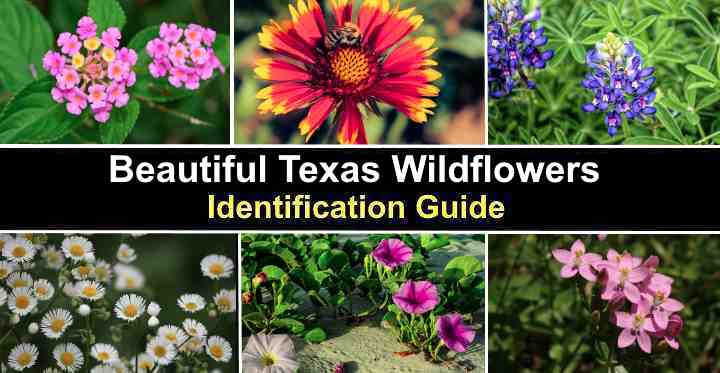
Texas wildflowers are a stunning sight to behold. With their vibrant purple, red, yellow, and pink colors, and unique shapes, wildflowers add beauty to landscapes in the Lone Star State. From the iconic bluebonnets to lesser-known species like the Indian paintbrush, Texas lantana, and fleabane, Texas wildflowers bloom throughout the year.
Texas wildflowers are found in a variety of habitats—from the dry, arid deserts of Western Texas to the hot, humid climates of Houston, Corpus Christi, and Dallas in the east and south. Wildflowers that thrive in the Texan landscape also thrive in gardens. They add color, texture, and beauty to front and back yards.
This article is an identification guide to 19 stunning Texas wildflowers. Descriptions and pictures of the state flower, bluebonnet, and other native wildflowers like the Indian blanket, brown-eyed Susan, and Mexican hat will help you identify these beautiful plants when you encounter them in the wild.
Flower Growing Zones in Texas
USDA growing zones in Texas range from Zone 6 in the northernmost parts of the state to zone 9 in the south. Knowing the growing zones helps you choose which plants can withstand the lowest temperatures in your area. However, heat, humidity, rainfall, and soil conditions can also affect growing conditions.
When choosing wildflowers to grow in your garden landscape, it’s vital to consider all factors to ensure healthy growth.
Common Wildflowers in Texas
The most common wildflowers growing in Texas are the Texas Bluebonnet (Lupinus texensis), Indian Paintbrush (Castilleja indivisa), Winecup (Callirhoe involucrata), and Texas spider lilies (Hymenocallis liriosme). These enchanting blooms range from blues and purples to fiery reds and sunny yellows, creating breathtaking floral displays.
Texas Wildflowers vs. Native Plants
Wildflowers are generally types of Texas native flowers that flourish without cultivation in open landscapes. These flowers often grow in open meadows, fields, roadsides, and wilderness areas. Wildflowers can include a variety of plant species, both native and non-native. Many non-native flowers have naturalized in Texas landscapes.
Native Texas plants are species that naturally occur in southern states. They thrive in the local climate and soil conditions and play an important role in the ecosystem. Typically, they maintain the habitat for native wildlife and are hosts for native insects and pollinators. Native Texas plants include more than wildflowers—they include shrubs, trees, and vines.
Texas wildflowers include a broad category of flowering plants that can be native and non-native species found growing in the wild.
Texas Wildflowers to Grow in Your Garden (With Pictures)
Let’s look in detail at some of the most stunning flowers growing in the wild in Texas landscapes. You will also find information about growing these attractive flowers in your gardens.
Texas Bluebonnet (Lupinus texensis)
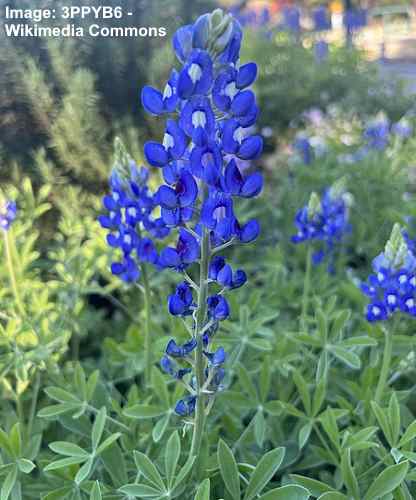
Texas bluebonnet is a native full sun wildflower with purple-bluish flowers
The Texas bluebonnet is a bluish-purple native wildflower in Texas. Bluebonnet flowers grow in various habitats, including prairies, fields, meadows, and roadsides. The native blue-flowering Texas bluebonnet has clusters of pea-like indigo-blue flowers on tall spikes topped with a white crown.
These blue-flowering plants grow 12” to 18” (30 – 45 cm) tall and bloom in early spring. They form a carpet of blue as the slender stems wave in the wind.
The Texas bluebonnet is the state flower of Texas and one of the most well-known wildflowers in the south.
Native to: Texas, Louisiana, Oklahoma
Bloom time: Early to late spring
Sun exposure: Full sun
When to plant: Scatter the seeds in the fall or plant transplants in early spring
Texas Spider Lily (Hymenocallis liriosme)
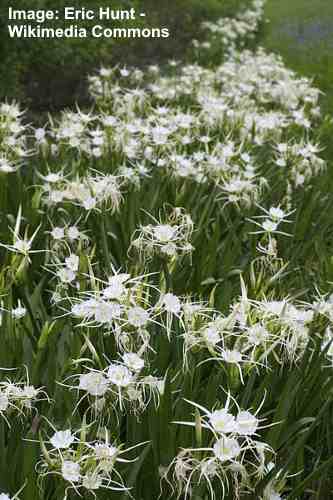
Texas spider lily wildflower produces attractive white flowers with spidery petals
Texas spider lily is a sun-loving bulbous wildflower that produces large, showy white flowers. The fragrant flowers have elongated, spidery petals and a funnel-like center that is pale yellowish-green. The flowers bloom in late spring or early summer and grow up to 18” to 24” (45 – 60 cm) tall.
Texas spider lily is an ideal wildflower for planting in sunny gardens, borders, or containers throughout Texas. The white-flowering plant thrives in bog gardens, water gardens, moist borders, and along the banks of streams.
Native to: Southeastern coastal regions of the United States, including Texas, Louisiana, Mississippi, Alabama, Georgia, and Florida
Bloom time: From February through September
Sun exposure: Full sun to partial shade
When to plant: Early spring, after the risk of frost has passed
Texas Bluebell (Eustoma exaltatum)
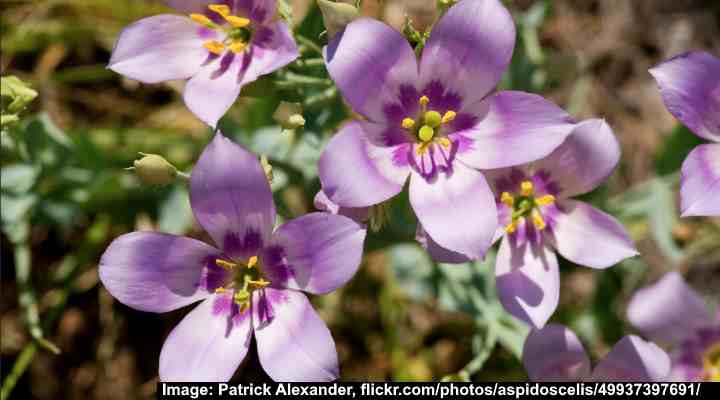
Texas bluebells are easy to grow purple and pink wildflowers that grow well in full sun
Texas bluebell is a beautiful purple wildflower found throughout Texas. Characteristics of the stunning flowering plant are its showy bell-shaped flowers in shades of blue, pink, white, and purple. The delicate-looking flowers grow on tall stems up to 3 ft. (1 m) tall.
Texas bluebells are perfect for growing in garden beds, borders, and containers. The native Texas flower is easy to care for and requires moderate watering and occasional fertilization. The flowers make excellent cut flowers and can be used in floral arrangements and bouquets.
Native to: Texas, Oklahoma, Louisiana, Arkansas, Alabama, and Mississippi
Bloom time: Mid-summer to early fall
Sun exposure: Full sun
When to plant: After the last frost date in early spring
Texas Lantana (Lantana urticoides)

The colorful lantana wildflowers grow well in the warm areas of Texas and southern USA
Texas lantana is a heat-tolerant perennial wildflower shrub with clusters of small, brightly colored red, yellow, orange, and purple flowers. The ornamental colorful plant grows 2 to 3 ft. (0.6 – 1 m) tall and wide and has a bushy habit. Its colorful blossoms attract native pollinators like butterflies, bees, and other beneficial insects.
Texas lantana is a low-maintenance plant that thrives in full sun and well-drained soil making it an ideal plant for a Texas wildflower garden. It is an ideal flower for planting in rock gardens, borders, or as a ground cover. The plant is drought-tolerant and can survive in hot, dry conditions. Despite the heat of South Texas, lantanas bloom through spring and summer.
Native to: Texas, Arizona, New Mexico, and other southern regions of the United States
Bloom time: April to September
Sun exposure: Full sun
When to plant: Sow seeds in late winter or root cuttings in mid-summer
Beach Morning Glory (Ipomoea imperati)
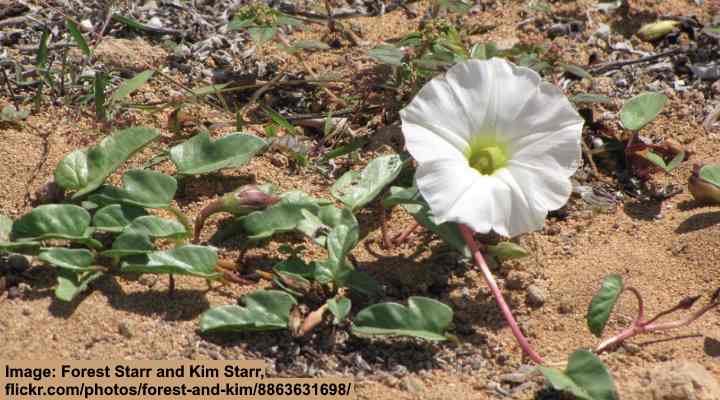
Beach morning glory is a perennial trailing wildflower that is suitable for coastal areas in Texas
Beach morning glory is a hardy perennial flowering vine that thrives in sandy, coastal areas in southern Texas. The ornamental feature of these wildflowers is their large, white or pink funnel-shaped flowers that bloom from late spring until fall. The hardy flowers withstand the scorching heat, salt water, and strong winds of the Texas coastline. Its funnel-shaped flowers measure 2” (5 cm) across.
Beach morning glory is perfect for planting on dunes or as a ground cover in hot, dry areas. Its trailing, scrambling, and creeping vines grow between 10 and 50 ft. (3 – 15 m) wide. Although it spreads quickly, the wildflowers are not invasive in Texas.
Native to: Florida, Texas, Mississippi, Alabama, Louisiana
Bloom time: From summer through fall
Sun exposure: Full sun
When to plant: Directly in the ground or in a container in early to mid-spring
False Purple Thistle (Eryngium leavenworthii)
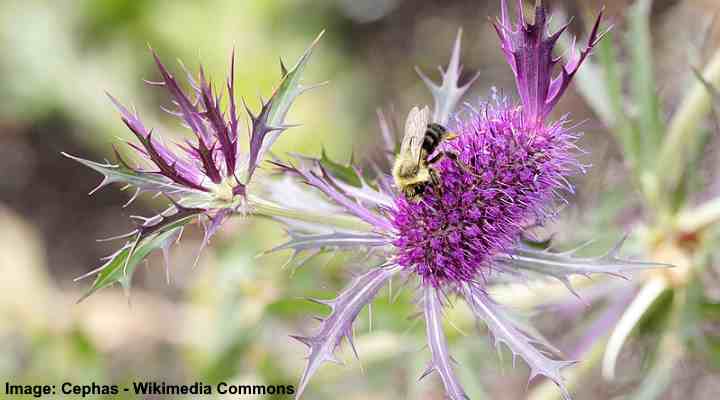
False purple thistle is a spikey drought tolerant Texas wildflower that blooms in summer and fall
The false purple thistle is a purple-flowering plant that thrives in meadows, prairies, and woodlands. The spiky plant is identified by its small clusters of purple flowers growing on thorny, purple-metallic stems. Additionally, it has deeply lobed leaves. When in bloom in late summer and early fall, it adds a pop of deep purple colors to fields.
The sun-loving purple prickly Texas wildflower with its unique spiky flowers grows up to 3 ft. (1 m) tall. It’s a hardy, heat and drought-tolerant plant that makes a striking addition to any garden landscape.
Native to: Southern and Central regions of the United States
Bloom time: From July through November
Sun exposure: Full sun to partial shade
When to plant: Sow the seeds in the fall and spring
Texas Thistle (Cirsium texanum)
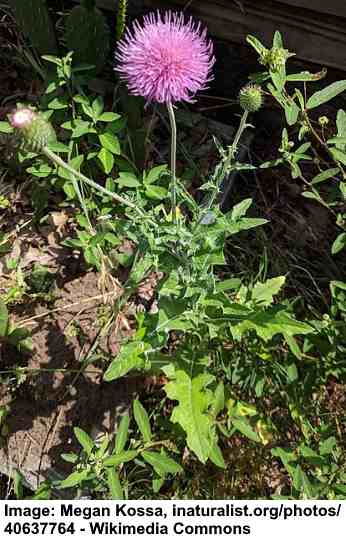
Texas thistle is a native Texas wildflower with purple-pink round flowers
The Texas thistle is a common purple wildflower in the southern states. The native sun-loving, drought-tolerant native wildflower produces beautiful pinkish-purple flowers. The spiky thistle plant has purple flowers growing on tall stems and covered in deeply lobed, spiky leaves.
The deep purple-colored pom-pom flowers and gray-green leaves add an interesting contrast to garden landscapes.
Texas thistle is an ideal plant for naturalizing a meadow or prairie landscape. The low-maintenance plant grows well in full sun and well-drained soil. It can also be used as a border plant or planted in mass for a stunning display of color. It grows 2 to 4 ft. (0.6 – 1.2 m) tall.
Native to: Prairies and meadows in Texas and northern Mexico
Bloom time: Late spring to early summer
Sun exposure: Full sun
Fleabane (Erigeron modestus)
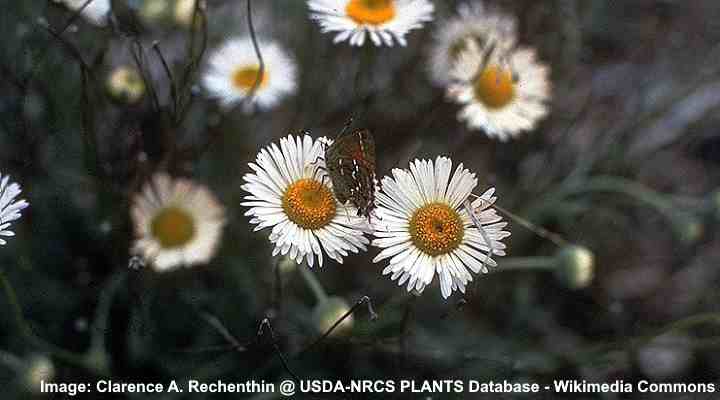
Fleabane is a heat tolerant full sun wildflower with daisy-like white flowers
Fleabane is a lovely white-flowering wildflower in Texas with daisy-like flowers. The flowers are disc florets consisting of white petals surrounding a yellow center and growing on slender stems. The low-growing plant grows 6 to 16 inches (15 – 40 cm) tall and spreads up to 2 feet (0.6 m) wide.
Fleabane is an ideal wildflower for rock gardens, borders, and container gardens in North, Central, and West Texas. The low-maintenance plant prefers full sun and well-draining soil. Its bright white and yellow flowers are a great addition to any hot, humid, or arid landscape.
Native to: Western and Central Texas, New Mexico, Arizona
Bloom time: Early spring through fall
Sun exposure: Full sun
When to plant: In early spring, when the risk of frost has passed
Mountain Pink (Centaurium beyrichii)
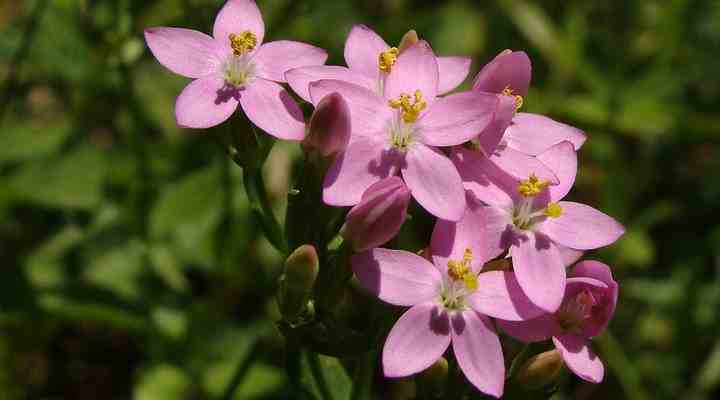
Mountain pink wildflowers can be used as ground cover for both sunny and partially shaded locations
Mountain pink is a Texas native wildflower that produces clusters of small, bright pink or purple star-shaped flowers. The flowers grow on stems that reach 12” (30 cm) tall. The low-maintenance wildflower is perfect for a rock garden or as a ground cover in full sun or partial shade.
Mountain pink thrives in dry, rocky soil. It’s suitable in a sunny landscape as a border plant or mixed with other low-growing plants to create a colorful ground cover with pink flowers.
Native to: Texas, Oklahoma
Bloom time: Late spring and summer
Sun exposure: Partial shade to full sun
Blackfoot Daisy (Melampodium leucanthum)
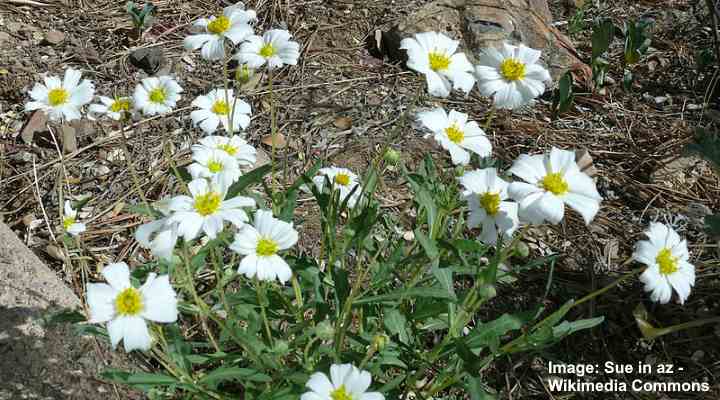
Blackfoot daisy is a flowering plant commonly seen growing in the wild in Texas prairies and meadows
Blackfoot daisy is an eye-catching Texas wildflower producing an abundance of small white aster-like flowers. The compact, rounded bushy plant grows in mounds of 6” to 12” (15 – 30 cm) tall and 24” (60 cm) wide. It’s an excellent low-maintenance white-flowering ground cover plant. It also performs well in rock gardens, borders, or containers.
Native to: Central and Western Texas, Arizona, Oklahoma, New Mexico
Bloom time: Early spring to late fall
Sun exposure: Full sun or partial shade
Texas Plume (Ipomopsis rubra)
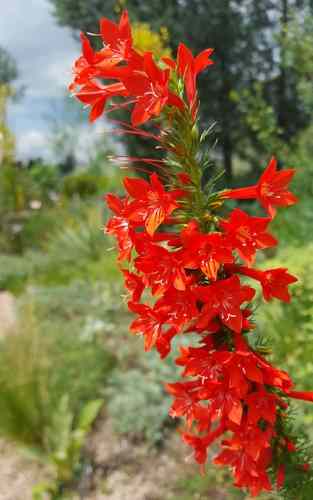
The beautiful Texas plume produces red flower clusters growing on tall stems
Texas plume is a stunning red-flowering wildflower with slender trumpet-shaped flowers growing on tall spikes. The bright red tubular flowers grow in clusters on stems with sparse foliage. The red flowers are ideal for back-of-the-border planting because they grow up to 6 ft. (1.8 m) tall.
Texas plume is an excellent choice for small gardens or container plantings. It attracts hummingbirds and other pollinators to southern gardens.
Native to: Most states in the United States
Bloom time: Early spring through fall
Sun exposure: Full sun and partial shade
Butterfly Weed (Asclepias tuberosa)
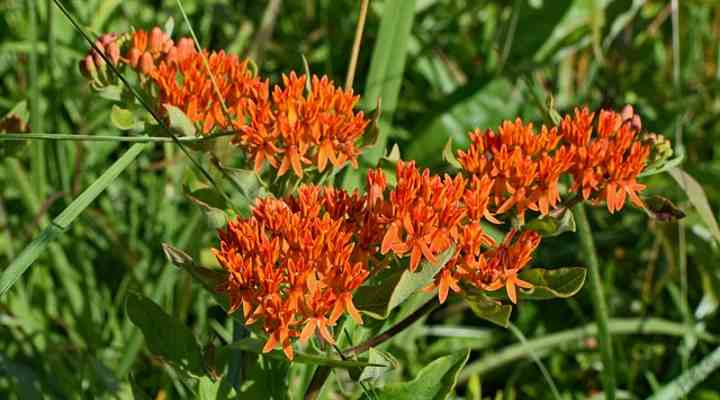
The orange flowering butterfly weed adds a pop of color to Texas hot and dry wild areas
Butterfly weed is a beautiful flowering plant growing in the wild throughout Texas. The ornamental feature of the low-growing plant is its clusters of bright orange flowers forming flat-topped clusters. The orange flowers grow on erect stems that reach up to 2 ft. (0.6 m) tall.
Butterfly weed is a low-maintenance plant perfect for hot and dry regions. Its ornamental blooms add a splash of vibrant color to Texan landscapes.
Native to: North America
Bloom time: Early spring through fall
Sun exposure: Full sun
Spotted Beebalm (Monarda punctata)
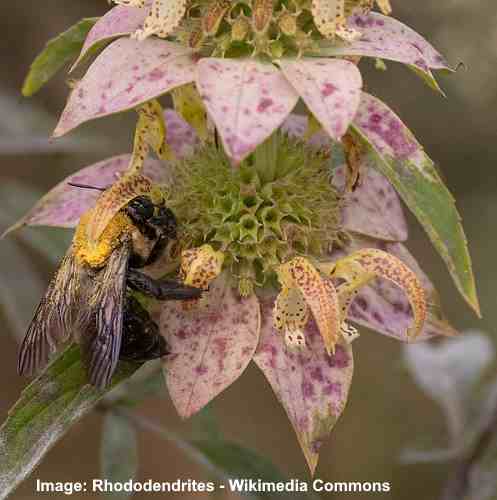
Spotted beebalm wildflowers attracts many pollinators and are a great addition to Texas gardens
Spotted beebalm, also known as dotted horsemint, has aromatic yellowish-green flowers surrounded by lavender-pink bracts. The attractive flowering clusters grow on spikes 3 ft. (1 m) tall. Spotted beebalm is an excellent addition to any garden landscape. The wildflower looks stunning in a sunny border, cottage garden, or wildflower meadow.
Native to: Prairies, savannas, meadows, and pastures in North America
Bloom time: From spring through fall
Sun exposure: Full sun
Blue-Eyed Grass (Sisyrinchium sagittiferum)
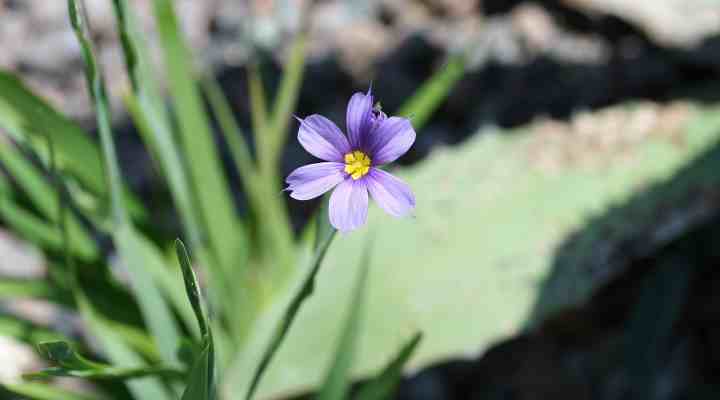
Plant blue-eyed grass en masse for a stunning effect when in flower
Blue-eyed grass is a charming blue-purple Texas wildflower with dainty star-shaped flowers. The plant has delicate pale purple flowers with yellow centers and is a member of the iris family. Blue-eyed grass grows 8” to 18” (20 – 45 cm) tall and wide. It’s an ideal clumping wildflower for planting in rock gardens, borders, or mixed containers.
Native to: Texas, Arkansas, Louisiana
Bloom time: From early spring until early winter
Sun exposure: Partial shade
Indian Blanket (Gaillardia pulchella)
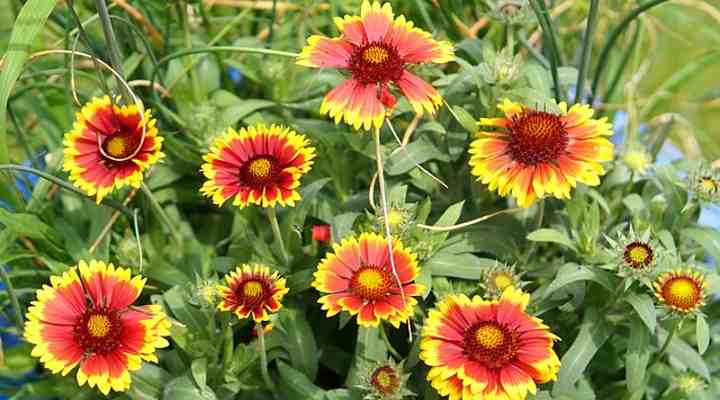
The beautiful Indian blanket wildflowers give a bright focal point to Texas gardens
Indian blanket is a colorful orange and yellow wildflower native to Texas and the south-central United States. These bright ray flowers feature red, yellow-tipped petals blooming on the ends of grow on long stems. The showy red disc blooms measure 3” (7.5 cm), creating a sea of red and yellow colors in full bloom.
Indian blanket is an easy-to-grow wildflower that thrives in hot and dry conditions, making it an ideal plant for a Texas wildflower garden. The plant grows 1 ft. (0.3 m) tall, and the red pinwheel flowers look spectacular in borders, rock gardens, butterfly gardens, or containers.
Native to: North America
Bloom time: Throughout the year in Texas
Sun exposure: Full sun or partial shade
Mealy Blue Sage (Salvia farinacea)
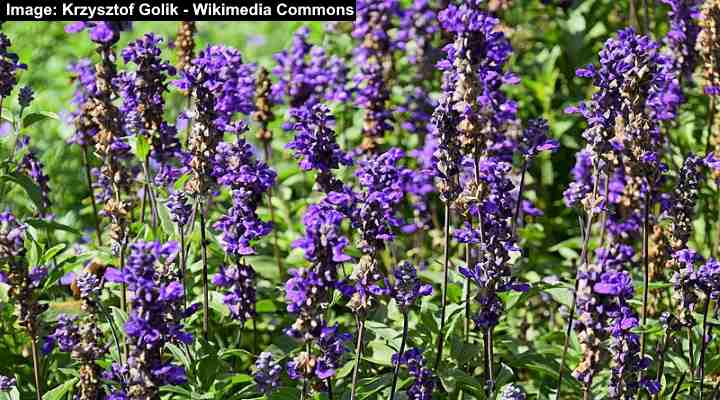
Mealy blue sage is a Texas wildflower with purple spiky flowers
Mealy blue sage is a purple-flowering wildflower that looks like a Texas bluebonnet. The ornamental feature of these blue-flowering plants is their tall spikes of densely packed violet, deep purple, and blue flowers. The sprawling wildflowers grow 1 to 2 ft. (0.3 – 0.6 m).
The blue flowers have five lobes and two lips and form slender, conical spikes on upright stems.
The heat-hardy mealy blue sage thrives in all Texas zones making it an ideal wildflower for a garden landscape in Texas. You can grow mealy blue sage in cottage gardens, mixed borders, or along a foundation line.
Native to: The Southern United States
Bloom time: Spring through fall
Sun exposure: Full sun
Texas Indian Paintbrush (Castilleja indivisa)
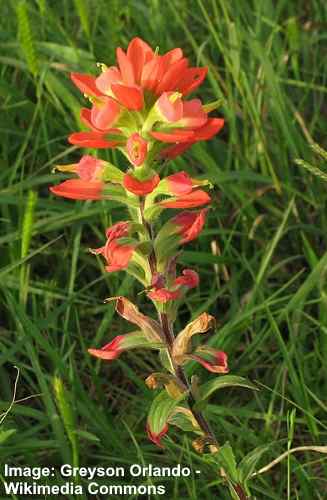
Texas Indian paintbrush is a red flowering native plant that looks best growing in mass plantings
Texas Indian paintbrush is a beautiful, native wildflower across Texas and the southern United States. The stunning flowers of this plant are a bright orange-red color and are shaped like a paintbrush—hence the name. The showy flowers form spikes measuring 3” (7.5 cm) tall, growing on stems that are 18” (45 cm) in height.
Native to: Texas, Oklahoma, Louisiana, Arkansas
Bloom time: Throughout the year
Sun exposure: Full sun
Mexican Hat (Ratibida columnifera)
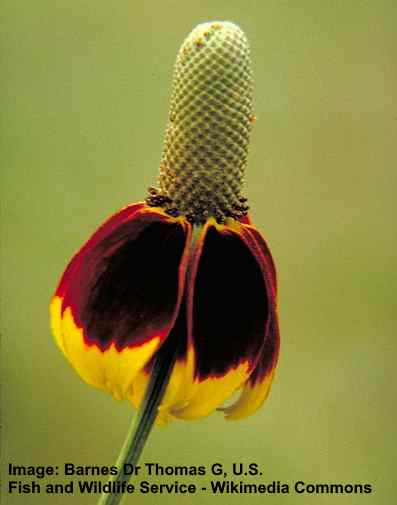
Mexican hat is a common wildflower in Texas
Mexican hat is a common wildflower in Texas landscapes and it features distinctive yellow and red-brown flowers. The unusual wildflowers consist of a conical center surrounded by drooping red and yellow petals, resembling a Mexican sombrero. The drought-tolerant Mexican hat plant grows 3 ft. (0.3 – 0.9 m) tall. It’s ideal for border plants, rock gardens, or wildflower gardens.
Native to: North America
Bloom time: From mid-spring through late fall
Sun exposure: Full sun
Pink Evening Primrose (Oenothera speciosa)
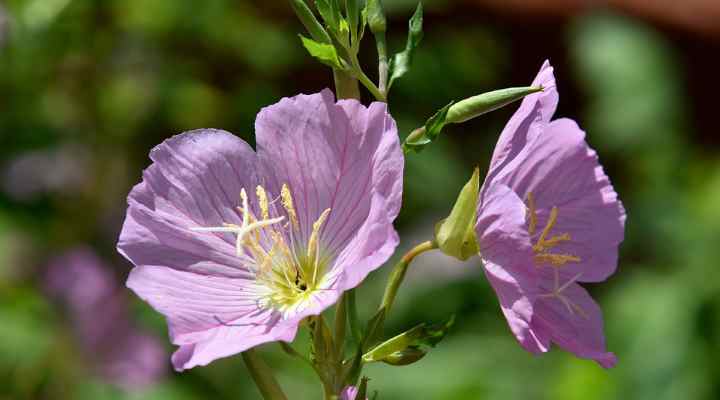
Pink evening primrose is a drought and heat tolerant Texas wildflower that performs best in full sun
Pink evening primrose flowers commonly grow in grasslands throughout Texas. The sprawling, low-growing easy-care wildflower features large, four-petaled, cup-shaped pink flowers. Like many evening primrose flowers, the pale pink blossoms open in the evening and close in the morning. The pink flowers have yellow centers and nicely contrast with the plant’s linear green leaves.
Pink evening primrose is a perfect flower for planting in rock gardens, borders, or as a ground cover throughout Texas. It is tolerant to heat and drought and can grow in poor soil conditions. The low-growing wildflower grows up to 1 to 2 ft. (0.3 – 0.6 m) tall.
Native to: North America
Bloom time: Late winter through late fall
Sun exposure: Full sun
Related articles:
